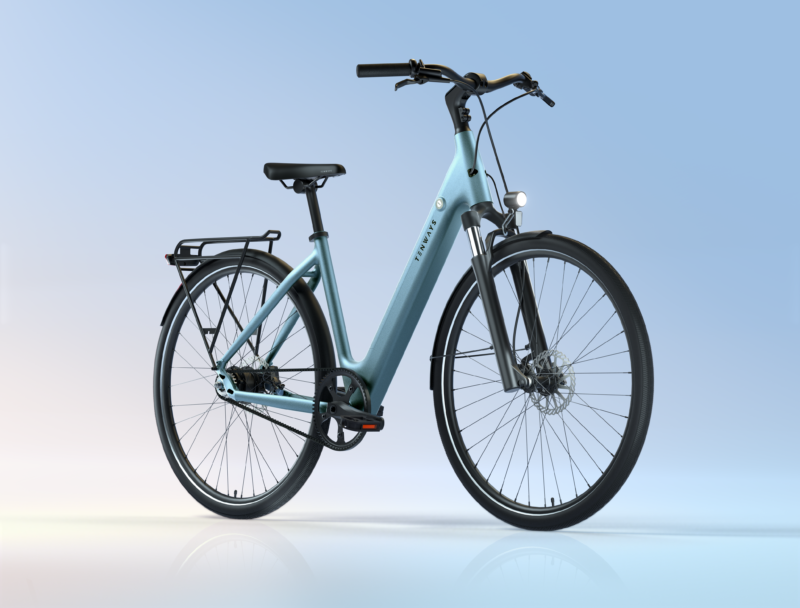
Tenways
I enjoyed riding the Tenways CGO800S far more once I stopped thinking of it as a bike, and more like the e-bike version of a reasonable four-door sedan.
It is a bike, to be sure. It has two wheels, handlebars, pedals, and a drivetrain between feet and rear cog. It’s just not the kind of bike I’m used to. There are no gears to shift between, just a belt drive and five power modes. The ride is intentionally “Dutch-style” (from a Dutch company, no less), with a wide saddle and upright posture, and kept fairly smooth by suspension on the front fork. It ships with puncture-proof tires, sensible mud guards, and integrated lights. And its 350 W motor is just enough to make pedaling feel effortless, but you’ll never quite feel like you’re winning a race.
I also didn’t feel like I was conquering the road when I was on the CGO800S so much as borrowing my aunt’s car for an errand. The “Sky Blue” color helped cement the image of a modern-day Mercury Sable in my head. It’s not meant for no-power riding, and its battery isn’t a long-hauler, with a stated 53-mile range. It’s comfortable, it’s capable, and maybe we’ve long since reached the stage of the e-bike market where some bikes are just capital-F Fine, instead of them all being quirky experiments.
All this is to say I didn’t have any real issues with the CGO800S itself, beyond some notable matters of build quality and wonky display software. There are e-bikes in the same $1,700 price range that look far more slick, have more traditional bike shapes and postures, or have a lot more range or power. But here’s this package of comfort, convenience, and capability, and once you get it assembled and tuned up, it’s quite handy.
-
Part of the Tenways’ CGO800S unboxing. If seeing a collection of wheels and handlebars makes you uneasy, you’d do well to contact your local bike shop.
Kevin Purdy -
Not the most helpful cable-routing instructions I’ve seen. Not the worst! But “Connect the wires and organize” could use some hinting.
Kevin Purdy
Not the smoothest setup experience
Tenways has a lot of work to do in shipping the CGO800S to customers and helping them get it set up. The bike ships with both wheels, handlebar, cabling, rack, and battery separate from the frame. That would be fine if everything went to plan. The instructions are not the worst I’ve seen ship with an e-bike, but they’re not easy if you don’t have experience.
The whole of the front cabling setup is a sentence repeated twice on one page: “Insert the connectors into the outlet hole at the lower part of the handlebars, and organize the outlet.” There are icons and illustrations vaguely indicating that you should match the colors of each connector end. There is no suggestion of which cables should be taut, which should have some slack to them, or what a good look for a finished “organized outlet” should be. Another page described the setup of the front headlight, mudguard, and front fork in a similarly vague fashion, leaving me to wrench and re-wrench the same nuts three times.
The front wheel I received was also significantly out of true (not properly rounded), such that I couldn’t use its disc brake until it was fixed. I’m not being hyperbolic about a perceived imperfection: I’ve built my own bike wheels, I’ve trued dozens of wheels for guests at a bike-fix clinic, and this wheel was pretty rough. I was able to get it close enough with a zip tie on the frame, but given that I’m a reviewer receiving this wheel, it seems like some inspection steps are missing.




















+ There are no comments
Add yours